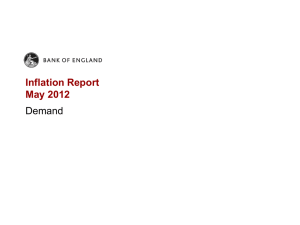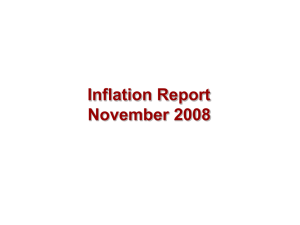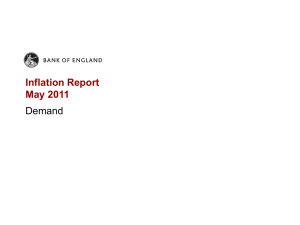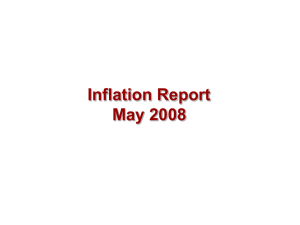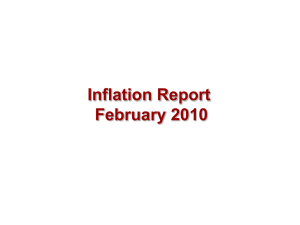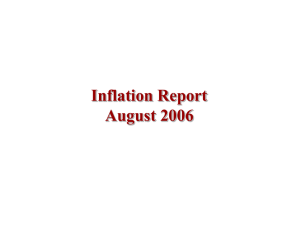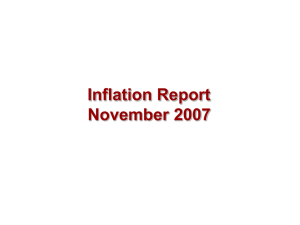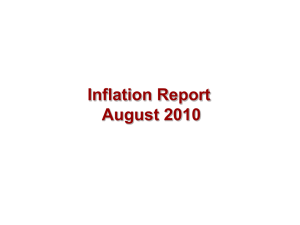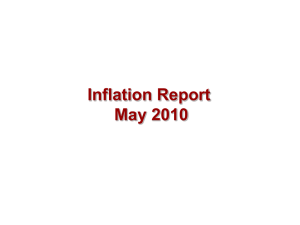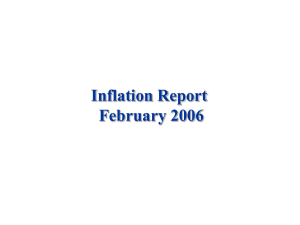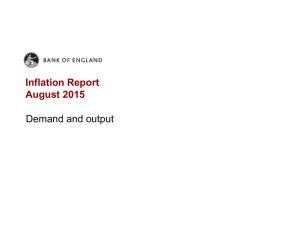Inflation Report February 2012 Demand
advertisement
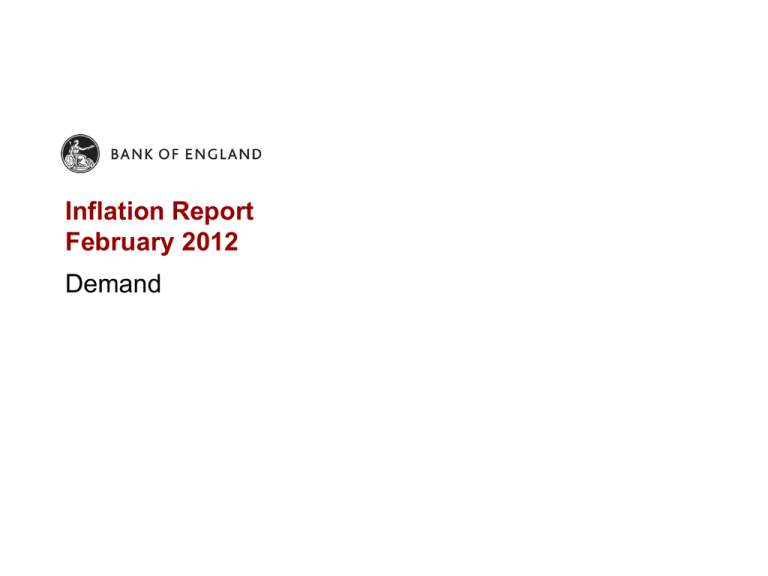
Inflation Report February 2012 Demand Chart 2.1 Contributions to four-quarter growth in nominal GDP(a) (a) At market prices. Contributions may not sum to total due to rounding. Chart 2.2 Contributions of expenditure components to changes in demand in recessions and recoveries(a) (a) Chained-volume measures at market prices. Recessions are defined as at least two consecutive quarters of falling output (at constant market prices) estimated using the latest data. The recessions are assumed to end, and the recoveries are assumed to begin, in the quarter that follows the trough in output. (b) Excluding the estimated impact of MTIC fraud. (c) Excludes the alignment adjustment. (d) Includes non-profit institutions serving households. (e) ‘Other’ includes the alignment adjustment and a statistical discrepancy. Chart 2.3 Household consumption and real income(a) (a) Includes non-profit institutions serving households. (b) Wages and salaries plus mixed income less taxes (including income taxes and Council Tax) plus net transfers (general government benefits minus employees’ National Insurance contributions), deflated by the consumer expenditure deflator. (c) Chained-volume measure. (d) Total available household resources, deflated by the consumer expenditure deflator. Chart 2.4 Household saving ratio(a) (a) Percentage of household post-tax income (not adjusted to account for the impact of Financial Intermediation Services Indirectly Measured). (b) Recessions are defined as in Chart 2.2. Chart 2.5 Survey measures of household expectations Source: Research carried out by GfK NOP on behalf of the European Commission. (a) Net balance of respondents reporting that they expect their personal financial situation to get better over the next twelve months. (b) Net balance of respondents reporting that they expect the general economic situation in the United Kingdom to get better over the next twelve months. (c) Net balance of respondents reporting that they expect the number of unemployed people to rise over the next twelve months. Chart 2.6 Business investment and surveys of investment intentions Sources: Bank of England, BCC, CBI, CBI/PwC and ONS. (a) Chained-volume measure. (b) Data are to 2011 Q4. Includes survey measures of investment intentions from the Bank’s Agents (companies’ intended changes in investment over the next twelve months), BCC (net percentage balance of companies who say they have increased planned investment in plant and machinery over the past three months) and CBI (net percentage balance of companies who say they have revised up planned investment in plant and machinery over the next twelve months), scaled to match the mean and variance of four-quarter business investment growth since 1999. Measures weight together sectoral surveys using shares in real business investment. Bank’s Agents’ data cover the manufacturing and services sectors. BCC data are non seasonally adjusted and cover the non-services and services sectors. CBI data cover the manufacturing, distribution, financial services and consumer/business services sectors. Chart 2.7 Factors likely to hold back investment(a) Sources: CBI, CBI/PwC and ONS. (a) Manufacturing, financial services, consumer/business services weighted by shares in real business investment. Companies are asked for their twelve-month forecast of factors likely to limit capital expenditure authorisations. Financial services companies are not asked to distinguish between a shortage of internal finance and an inability to raise external finance, so their single response is used for the question on inability to raise external finance. Chart 2.8 Survey measures of global output growth(a) Sources: HSBC, JPMorgan Chase & Co., Markit Economics, Thomson Reuters Datastream, US Bureau of Economic Analysis and US Institute for Supply Management (ISM). (a) Published composite indices of manufacturing and service sectors, unless otherwise stated. A figure over 50 indicates rising output compared with the previous month, and a figure below 50 indicates falling output. (b) Based on the results of surveys in 30 countries, accounting for an estimated 86% of global GDP. (c) Manufacturing production and non-manufacturing business activity ISM survey indices, weighted together using their nominal shares in value added. Chart 2.9 US unemployment rate Sources: Bureau of Labor Statistics and National Bureau of Economic Research (NBER). (a) Recession bars use NBER dating methodology. Chart 2.10 UK goods exports and surveys of export orders Sources: BCC, CBI, CIPS/Markit and ONS. (a) Includes measures of manufacturing export orders from BCC, CBI and CIPS/Markit scaled to match the mean and variance of quarterly goods export growth since 2000. BCC data are non seasonally adjusted. (b) Excluding the estimated impact of MTIC fraud. Chart 2.11 UK current account (a) Includes compensation of employees. Tables Table 2.A Expenditure components of demand(a) (a) (b) (c) (d) (e) Chained-volume measures. Includes non-profit institutions serving households. Excludes the alignment adjustment. Percentage point contributions to quarterly growth of real GDP. Excluding the impact of missing trader intra-community (MTIC) fraud. Table 2.B Stockbuilding and surveys of stock adequacy Sources: CBI and ONS. (a) Chained-volume measures. Excluding the alignment adjustment. (b) Averages of monthly data. Net percentage balances of companies that say that their present stocks of finished goods are more than adequate (manufacturing) or are high in relation to expected sales (distribution). Table 2.C Public sector net borrowing(a) Sources: HM Treasury, OBR Economic and Fiscal Outlooks (EFO) and ONS. (a) Measures exclude the temporary effects of financial interventions. Data are for financial years, for example 2009 refers to the financial year 2009/10. Table 2.D Euro-area survey measures of confidence and bank credit conditions Sources: ECB and European Commission. (a) Bank credit conditions averages are calculated since 2002 Q4. (b) Averages of monthly data. (c) Weighted average of the industrial confidence indicator, the services confidence indicator, the retail confidence indicator and the construction confidence indicator, based on the weights of those indicators in the economic sentiment indicator. (d) Weighted net percentage balances of banks reporting that their credit standards as applied to the approval of loans to households for house purchase/loans to businesses had tightened over the past three months. Weights reflect national shares in total outstanding euro-area lending to euro-area residents. Housing market activity and GDP Chart A Housing transactions and house building Sources: Department for Communities and Local Government, HMRC, ONS and Bank calculations. (a) Recession is defined as in Chart 2.2. (b) Number of residential property transactions in the United Kingdom with a value of £40,000 or above per quarter from 2005 Q2. Prior to that date, the series has been assumed to grow in line with quarterly HMRC data on transactions in England and Wales. (c) Number of permanent dwellings in the United Kingdom started/completed by private enterprises up to 2011 Q1. Data for 2011 Q2 and Q3 have been grown in line with permanent dwelling starts/completions by private enterprises in England. Data are non seasonally adjusted. Table 1 Contributions to GDP of spending related to housing(a) (a) Chained-volume measures at market prices. (b) Includes spending on: furniture and furnishings; carpets and other floor coverings; household textiles; and major appliances (electrical or otherwise).
